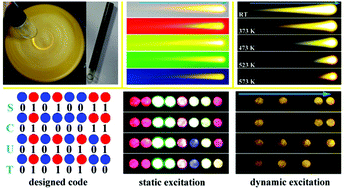Photon upconversion afterglow materials toward visualized information coding/decoding†
Abstract
The development of a luminescent material with visualized afterglow plays a crucial role in information security. Herein, a long-lived phosphor, KCaF3:Yb3+,Mn2+, with a visualized photon upconversion (UC) afterglow is presented. The UC emission spectrum consists of a high color purity (∼99.33%) yellow emission band peaking at ∼570 nm, and the UC afterglow signal can be observed by the naked eye in both bright and dark fields even at a high temperature of 200 °C. Moreover, the demonstration background and pigments have little influence on the UC afterglow identification. The density functional theory (DFT) calculations and the up-/down-conversion luminescence characteristics suggest that the UC afterglow originates from the long-lived exchange coupled Yb3+–Mn2+ dimers formed in KCaF3:Yb3+,Mn2+, which is independent of the conventional “afterglow trap”. The random distribution characteristics of Mn2+, and the oxygen ion (O2−) introduced by Yb3+ non-equivalent doping are the key factors for forming the efficient UC emission center in this system. Using the photon UC afterglow phosphor in screen printing ink, a visualized information encoding/decoding prototype suitable for both human and machine fast identification is demonstrated.

- This article is part of the themed collection: Journal of Materials Chemistry C HOT Papers


 Please wait while we load your content...
Please wait while we load your content...